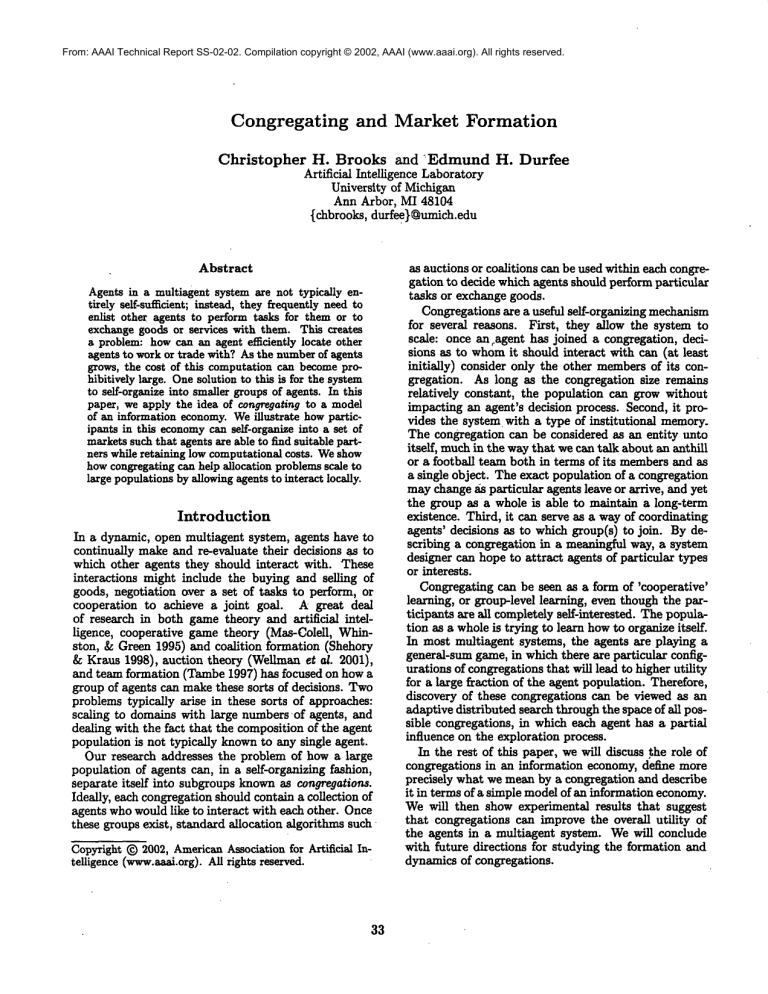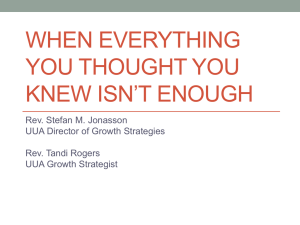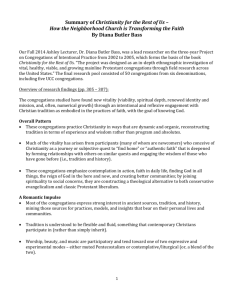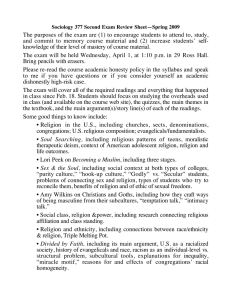
From: AAAI Technical Report SS-02-02. Compilation copyright © 2002, AAAI (www.aaai.org). All rights reserved.
Congregating
Christopher
and Market Formation
H. Brooks
and ~Edmund H.
Artificial Intelligence Laboratory
University
of Michigan
Ann Arbor,MI 48104
{chbrooks,
durfee}@umich.edu
Abstract
Durfee
asauctions
or coalitions
canbe usedwithin
eachcongregation
to decide
whichagentsshould
perform
particular
Agents
in a multiagent
system
arenottypically
entasksor exchange
goods.
tirely
self-sufficient;
instead,
theyfrequently
needto
Congregations
area useful
self-organi~.ing
mechanism
enlist
otheragents
to perform
tasksforthemor to
for several
reasons.
First,theyallowthesystemto
exchange goods or services with them. This creates
scale:oncean ~agenthasjoineda congregation,
decia problem: howcan an agent efficiently locate other
sionsas to whomit shouldinteract
withcan(atleast
agents to workor trade with? As the numberof agents
grows, the cost of this computation can becomeproinitially)
consider
onlytheothermembers
of itsconhibitively large. Onesolution to this is for the system
gregation.
As longas thecongregation
sizeremains
to self-organize into smaller groups of agents. In this
relatively
constant,
thepopulation
can growwithout
paper, we apply the idea of congregating to a model
impacting
an agent’s
decision
process.
Second,
it proof an information economy.Weillustrate howparticvidesthesystemwitha typeof institutional
memory.
ipants in this economycan self-organize into a set of
Thecongregation
canbe considered
as an entityunto
marketssuch that agents are able to find suitable partitself,
muchinthewaythatwecantalkaboutan anthill
ners while retaining low computationalcosts. Weshow
or a football
teambothin termsof itsmembers
andas
howcongregatingcan help allocation problemsscale to
a singleobject.
Theexactpopulation
of a congregation
large populationsby allowingagents to interact locally.
maychange
as particular
agents
leaveor arrive,
andyet
the groupas a wholeis ableto maintain
a long-term
Introduction
existence.
Third,
it canserveas a wayof coordinating
agents’
decisions
as to whichgroup(s)
to join.By deIn a dynamic,
openmultiagent
system,agentshaveto
scribing
a
congregation
in
a
meaningful
way,a system
continually
makeandre-evaluate
theirdecisions
as to
designer
canhopeto attract
agents
of particular
types
whichotheragentstheyshouldinteract
with.These
or
interests.
interactions
mightincludethebuyingandsellingof
Congregating
canbe seenas a formof ’cooperative’
goods,negotiation
overa setof tasksto perform,
or
learning,
or
group-level
learning,
eventhough
theparcooperation
to achievea jointgoal.A greatdeal
ticipants
are
all
completely
self-interested.
The
populaof research
in bothgametheoryandartificial
inteltionas a wholeistrying
tolearnhowto organize
itself.
ligence,
cooperative
gametheory(Mas-Colell,
WhinIn mostmultiagent
systems,
the agentsareplayinga
ston,& Green1995)andcoalition
formation
(Shehory
general-sum
game,in whichthereareparticular
config& Kraus1998),auction
theory(Wellrnan
et al.2001),
urations
of
congregations
that
will
lead
to
higher
utility
and teamformation
(Tambe1997)hasfocusedon how
fora largefraction
of theagentpopulation.
Therefore,
groupof agentscanmakethesesortsof decisions.
Two
of thesecongregations
canbe viewedas an
problems
typically
arisein thesesortsof approaches: discovery
adaptive
distributed
search
through
the
spaceof allposscaling to domains with large numbers of agents, and
siblecongregations,
in whicheachagenthasa partial
dealing with the fact that the composition of the agent
influence
on theexploration
process.
population is not typically knownto any single agent.
In
the
rest
of
this
paper,
we willdiscuss
theroleof
Our research addresses the problem of how a large
congregations
in
an
information
economy,
d’efine
more
population of agents can, in a self-organizing fashion,
precisely
what
we
mean
by
a
congregation
and
describe
separate itself into subgroups knownas congregations.
it in termsof a simple
modelofan information
economy.
Ideally, each congregation should contain a collection of
We
will
then
show
experimental
results
that
suggest
agents whowould like to interact with each other. Once
that
congregations
can
improve
the
overall
utility
of
these groups exist, standard allocation algorithms such
the agentsin a multiagent
system.We willconclude
withfuturedirections
forstudying
theformation
and
Copyright (~) 2002, AmericanAssociation for Artificial Indynamics
of congregations.
telligence (www.aaal.org).All rights reserved.
33
Congregating
in Information
Economies
through auctions, each of which was described using an
ontology which indicated the goods being bought and
sold. These auctions were instantiated via the Auction
Manager Agent (AMA), which would dynamically create new auctions when it noticed unsatisfied consumer
demand and delete auctions when they experienced a
lack of activity. This was a centralized process which
allowed for the partitioning of the market space into
separate congregations, makingthe location of potential customers or goods a manageable process for the
agents involved, as well as the humanusers.
In our exploration of congregating and market formation, one goal is to reproduce this process without
the intermediation of a centralized market maker (the
AMA).Instead, we propose that this functionality can
be handled by a distributed set of market makers, each
of which has the goal of attracting buyers and sellers
such that its market is successful (measured in terms
of either number of trades or surplus generated). In
essence, we would like for the formation of multiple
markets, each of which is composedof buyers and sellers with complementary interests,
to be an emergent
phenomenon. The purpose of this work is to identify
whether congregating can in fact be a viable strategy
for a large group of self-interested agents.
Our past research (e.g. (Brooks et al. 1999; Brooks,
Durfee, & Das 2000)) has focused on how producers
an information economycan locate consumer niches and
efficiently learn the preferences of consumersin these
niches. It is this first problem, that of locating a niche,
that is most relevant to congregating. In this problem,
two or more producers are each separately selecting a
setof goodsto sellanda pricing
mechanism
forthese
goods.In doingthis,theyseparate
theconsumer
populationintooneor moremarkets,
eachof whichbuys
fromoneproducer,
plusthemarketconsisting
of consumerswhochoosenot to buy fromany producer.
Each
producer’s
problem
isthentofinda profitable
location
in price/product
space,subject
to thedecisions
of the
otherproducers.
In thispaper,we taketheproblem
of marketformationonestepfurther,
anddrawdirectly
on thecongregatingmetaphor
to examine
theprocess
of marketformationin a multiagent
systemcontaining
a largenumberof producers
andconsumers.
Elsewhere
(Brooks
Durfee2002),we present
a general
modelof congregations,focusing
on theaffinity
groupdomain.
Thiswork
showed how congregating can be difficult when the solution space is very sparse, and suggested the introducCongregations
tion of labelers as a signaling mechanismthat served to
In this section, we define more precisely what we mean
coordinate agents’ decisions. It also showed how congregating could be used to improve average payoff when
by a congregation, both generally and in terms of our
agents with heterogeneous preferences played a coordiinformation economy model. A more detailed presentanation game. Our current paper applies congregating to
tion of this model(with minor differences) can be found
information economies. Weshow how congregating can
in (Brooks& Durfee 2002).
be used to stimulate producers and consumers in an inWe beginby considering
a generalmodelof a mulformation economyto self-select into separate markets
tiagentsystem.Let A = {al,a2,...,a,~)
be a set of
so that the average profit in the system is increased.
agentsin thesystemat timet. (Foreaseof presenThe effectiveness of this approach depends upon the
tation,we willassumediscrete
time.However,
nothnumberof markets available, as well as the specificity
ingin ourmodelrequires
it.)Theessential
criterion
of agent preferences.
forcongregating
to be an interesting
problem
is that
eachagentneedsto interact
withsomeothersubsetof
In manylarge-scale economies, the problem of whoto
theagents
inthepopulation.
Inutility-theoretic
terms,
buy or sell from is a significant one. Mechanismssuch
each agent a has a utility function U~ : P(A) -+
as auctions which pair buyers and sellers can be used to
(P(A) is the power set of all agents.) This function
do this when the number of agents is relatively small,
dicates the utility that agent a receives from interacting
but if the population is large or the auction is combiwith a particular set of other agents.
natorial, both the allocation of goods and the selection
of bids becomes a difficult computational problem. A
It is assumedthat an agent cannot interact with every
other agent, due to computational and communication
solution to this is to construct several smaller auctions,
each of which contains buyers and sellers with ’similar’
constraints. (Recall that n is large.) Therefore, at every
interests.
time t an agent will need to choose a subset of agents
to interact with.
One inspiration for this approach was the UniverCongregations are a way of simplifying this decision
sity of Michigan Digital Library (UMDL)
(Duffee al.
problem; rather than choosing agents from the entire
1998), which was a market in which automated agents
population of size n, an agent can join a congregation
would buy and sell information goods. The UMDL
contained consumers with manydifferent interests, and
of size c <~ <: n. This allows the agent to reduce the size
of its search problem by considering the c agents in its
providers offering a wide set of different types of articles. Each consumer had a User Interface Agent (UIA)
congregation to interact with. Additionally, in domains
in which agents have symmetric interests (meaning that
that located sellers of relevant information goods. The
sellers were also represented by agents, knownas Col.
if agent a wants to interact with agent b, then b wants to
interact with a), forming congregations will improve an
lection Interface Agents (CIA). These agents interacted
34
agent’s
chances
of a ’successful’
interaction
byallowing
agents
to grouptogether
withotherlike-minded
types.
Mostgenerally,
a congregation
c is simplya tuple
< l,Ac,t >,where
Acisa setofagents
{ai,...,aj}who
haveallcollocated
at a ’location’
l at timet. (This
neednotbea physical
location;
it couldbea particular
multicast
address,
radiofrequency,
or mailing
list.The
pointis thattheycommunicate
onlywithotheragents
in thecongregation.)
We assumeforsimplicity
thatan
agentis onlya memberof onecongregation
at a time;
futureworkwillrelaxthisassumption.
A congregation
is defined
intrinsically
by itsmembership.
It maybe
usefulforthemembers
of a congregation
or forother
agents,
suchas market
makers,
to tryto describe
a congregation
e~-~rinsically
by characterizing
somequality
shared
byitsmembers,
butthisisjusta label.
Letus makethisallmoreconcrete
by placing
it in
termsof an information
economy.
Our setA of agents
consists
of twodisjoint
subsets:
a setB ofbuyers
anda
I Ourcommodity
setS of sellers.
is information
goods:
an information
goodis an article
of a particular
categoryc E {ci,...,ck}.
Examples
of categories
include
Sports,
Arts,International
News,andso on.At each
timet, a seller
is ableto select
a typeofgoodtooffer.Eachbuye
has
a
category
c*
of goodthatit most
r
prefers;
articles
inthiscategory
havea reservation
value
r. A goodfromanother
category
c’ is valuedat:
other,
or a morecentralized
mechanism
suchas an auction,wherebidsaresubmitted
to a central
authority
whichcomputes
allocations.
In eithercase,thereis
somecomputation
thatmustbe performed
in orderto
determine
an allocation.
In thecaseof Contract
Net,
thiscomputation
is the exchange
of messages,
and in
thecaseof an auction,
it is thewinnerdetermination
algorithm.
In eithercase,thiscomputation
doesnot
comeforfree;we assumethatthe agentsin the systemmustpayforit.By separating
intoseparate
congregations,
theycaneasetheircomputational
burden,
hopefully
without
a largedecrease
in theefficiency
of
theallocation
of goods.
In fact,thegoalof theexperimentsin thispaperis to determine
how muchgross
efficiency
is lost,howmuchcomputation
is saved,and
theresulting
netcostsas thenumberof congregations
isvaried.
In orderto capture
thisnotionof agentsseparating intosubgroups,
ourmodelalsoconsists
of a set
M = (m1,...,mq}of markets.Theseare the locationsdescribed
above;buyersandsellers
willcongregatehere.Eachbuyersandsellerwillchooseexactly
one marketfrom M to join.At a time t, the marketwillcloseandanallocation
willbe computed
forall
agents
inthemarket.
Thecostofthisallocation
willbe
sharedequallyamongstallagentsin the market.The
mechanism
we useis a standard
Nth-price
Vickreyauction.
This
was
chosen
for
simplicity;
since
all
goodsare
-dl
privately
valuedandthereis no resale,
thedominant
V(c’)= r(l [c* k- )
(I)
strategy
is foragents
to bidtheiractual
valuations
for
Notethatthisassumes
thatcategories
arearranged
acarticles
(MacKie-Mason
& Varian1994).However,
any
cording
to a ’similarity’
metricon thek axis.While
allocation
mechanism
canbe usedin thismodel.
If costs
thisisa simplification,
itissufficient
forourneeds.
It
aresuperlinear
in thenumber
of agents,
thesamequalalsoprovides
ourmodelwithsomesimilarities
to the
itative
effects
willbe seen.EachbuyerbidsitsreserHotelling
model,whichis a commoneconomicframevationvalueandthepricesandallocation
of goodsis
workforproduct
differentiation.
Hotelling
models
typcomputed.
Ea~ agentcan thendecidewhetherto reicallycontainone or moreproductdimensions
along
mainin thiscongregation
or leaveforanother;
thisdewhichproducers
candifferentiate
themselves,
andconcision
willbebasedon whether
thevaluereceived
(less
sumerswithheterogeneous
preferences
alongthesedicomputation
cost)exceeds
theagent’s
threshold.
mensions.
Eachproducer
mustdetermine
whereto loClearly,
ina single
market,
theallocation
whichmaxcate,giventheexpected
locations
of theotherproducimizese~iciency
canbe computed.
Thiswillbe usedas
ers.Anderson,
et al. (Anderson,
de PMma,& Thisse
a benchmarkin our experiments.
However,comput1992)providea thorough
overview
of Hotelling-style ingtheoptimal
allocation
in a combinatorial
auction
is
models.
NP-complete
(Sandholm
2001),whichmeansthatthe
In ourmodel,eachagenta hasa threshold
~-~which
computational
costswillbe prohibitively
largeas the
indicates
thefraction
of r it wantsto receive
froma
numberof agentsin a marketbecomeslarge.Evenin
transaction.
Thisthreshold
canbeinterpreted
either
as
simpler
allocation
problems,
suchas coalition
formaa production_or
consumption
cost,or as a formof saristion,the numberof messages
exchanged
is polynomial
ricing,
whereby
alltransactions
yielding
utility
greater
in thenumberof agentsin thesystem,
whichleadsto
than~’ax r areconsidered
satisfactory
by agenta.
scalability
problems
as thenumberof agentsbecomes
In a simpleworld,thiswouldbe allthatis needed
large.
fora model;buyersandsellers
couldbe pairedup usElsewhere
(Brooks& Durfee2002),we haveanalyzed
ingsomesortof predetermined
mechanism,
eithera detheconvergence
properties
for a simplecongregating
centralized
mechanism
suchas Contract
Net (Davis
model,
focusing
on thelength
of timeneeded
fortheopSmith1983),in whichagentsbroadcast
offersto each
timalsetof congregations
to form.Thatworkshowed
thatcongregating
canleadto highernetutility
in doIWeassume’that
there
isnoresale;
buyers
consume
their
mainswhereagentstryto locateotheragentsof the
goodsimmediately.
Economies
containing
supply
chains
are
same"type".One observation
fromthatworkis that
alsoa promising
areaofapplication
forcongregations,
but
congregating
isuseful
because
ithelpsto builda "critarenottreated
here.
35
icalmass;"
a groupof agents
willforma congregation
Average
pmllti:er narstienis number
of nvukem
immNmn
thatis mutually
beneficial,
andsothecongregation
will
persist
overtime.Thisprovides
a focalpoint
fortheat300
traction
of otheragents
thatmaywantto be a partof
thiscongregation.
Essentially,
thecongregation
allows
250
a subsetof agents
to "holdstill"andallowothersto
findthem.
Inthispaper,
weareexplicitly
interested
inthelearn|,.
ingdynamics
of marketformation:
whatdo thetransitional
congregations
looklike,howareagents’
aggre10o
gateprofits
affected
by thecongregating
process,
and
whether
congregating
canimprove
overall
profit
by pro5O
, ,, , ,In"
viding
thissortof critical
mass.Dueto thecomplexity
of the problem
andour desireto examinethetransi[
, , ..
-,
0
, , ....
0
’
100
1(]oo
tionalbehavior
of thesystem,
we focuson experimenNurn~lra( .qm~mw
talmethods
to determine
whencongregating
is a viable
strategy,
andhowoverall
profits
(asa measure
ofsysFigure 1: Cumulativeprofit per iteration over all sellers,
temperformance)
changeas the numberof marketsis
averaged across 10 runs of 1000 iterations each (x axis
altered.
is log scale)
P.~mputJ~nJ ~ m numb~ el ~ ~- Inemam~
Using Congregationsto Improve Net
Profit
4O0
In thissection,
we present
experiments
demonstrating
theusefulness
of congregating
whenagentsmustincura
computation
costforcomputing
an allocation
of goods.
We showhow congregating
is a usefulstrategywhen
agentsmustpay forcomputation,
andstudytheefliciencyof theallocation
(bothgross,pre-computation
costandnet,post-computation)
as thenumberof marketsisvaried.
In thefirstexperiment,
we consider
an information
economycomposedof 50 producers
and 50 consumers.
Thereare 10 categories
of information
goods;at the
’
10
1~
beginning
of the experiment,
eachproducer
randomly
chooses
a category
of goodto sell.Eachconsumer
also
Figure 2: Cost of determining the optimal allocation
hasa favorite
category
(drawnfroma uniform
distribution)
andpreferences
overnon-favorite
goodsindiof goods as the number of markets increases (avercatedby equation1. Reservation
valuesfor a conaged over 50 instantiations with 50 producers and donsumer’smost-preferred
goodaredrawnfromU[5,10].
sumers).
Thenumberof markets
is fixedat thebeginning
of the
experiment;
it is assumed
thatallagentsknowm, the
numberof markets,
andallagentshaveagreedto share
of congregations
is varied
whenagents
exhibit
somesort
equally
in thecostsof computation
in determining
an
of adaptivebehavior.Randommovementis meantto
allocation.
We assumethatcomputation
hasa costof
provide
an approximation
of "typical"
agentbehavior
0.1 foreachmessagesentor comparison
made.Since
whenthepopulation
is large.)
we areusinga generalized
Vickrey
auction
to compute
allocations,
it isstraightforward
forthemarket
to hold
FigureI showstheaverage
cumulative
profit
achieved
an auction,
determine
thecostof thiscomputation,
and
by allsellers
(averaged
across
1000iterations)
asthe
charge
eachagentaccordingly.
numberof markets
is increased.
As thenumberof marAftereachmarketclosing,
everyagentis ableto
ketsisincreased,
initial
profits
aremuchlower,
as it
becomesmoredimcultforeachagentto locatea conchange
markets.
If theproducer
receives
lessthan~"x r
gregation
in whichit canfinda suitable
match.Also,
foritsgood,,orif a consumer
receives
a goodthatit
values
at lessthanT X r, itwillmovetoa newcongrethe systemas a wholereachesa suboptimal
configugation
chosen
at random.
In ourinitial
experiments,
~ration.
However,
thisfiguredoesnottakeintoaccount
wassetto 0.5forallagents.
Thisisvaried
in section. thecostsof computation.
Figure2 showshowcomputational
costsfalloffquickly
whentheeconomy
contains
(Notethatwe are not advocating
randommovement
as
an optimal agent strategy. Instead, we are interested in
morethanone market.Thesetwographsare combined
characterizing the behavior of the system as the number
infigure
3.Inthisfigure,
wecanseethat,
eventhough
a
36
300
.
.o
,
Average
NetPmnl
perItemllon
,
,
....
~ ...... ~.-..
I" ¯ "" ...........
,
" ,
..............
25O
~....-r..~,,~.~..rrr:..’:’:’.’.
.......................
2OO
2OO
!
Z/
5O
0
.5o
0
0
i
100
i
200
i
300
i
400
i
SO0
i
(~0
l
?00
i
800
gO0
1000
,
q~
,
,
.....
i
tO
,
NumbMof
Figure 3: Net cumulative profit per iteration over all
sellers, averaged across 10 runs of 1000iterations each.
single market is able to computethe optimal allocation,
the computational costs are high enough that producers end up with a negative net profit. As the number
of markets is increased, the computational cost falls off
muchmore quickly than profit, until at 25 markets the
average cumulative net profit is maximized. As more
markets are added, net profits begin to decline, as the
computational savings is outweighed by the difficulty of
finding a market cont~.in!ug a suitable matchup.
In figure 3, we can see the dynamics of market formation as the number of markets is increased. With a very
small number of markets (3 or 5) a stable configura-tion is reached almost immediately. As we increase the
number of markets to 10 or 25, convergence is slightly
slower, but the configuration of congregations that is
found yields higher average profit. As the number of
markets is further increased, the quality of the configuration falls off slightly, and convergence time becomes
muchlonger. It is difficult to quantify this comparison directly from figure 3, due to the number of lines
and the fact that total performance is actually the area
under each curve. Figure 4 makes this tradeoff more
explicit; it showsthe average net profit (over 1000 iterations) as the number of markets is increased. Here we
can clearly see that net profit increases steeply as the
numberof markets is increased, and then falls off after
m--25.
Wecan also see that introducing too many markets,
as in the case of m = 250 or m = 500, introduces too
muchinefficiency without a significant extra reduction
in computational cost. Buyers and sellers spend a great
deal of the initial iterations in a marketwith no suitable
agents.
In our next experiment, we examine whether the advantages of congregating scale as the number of agents
jn the system is increased. Wevary the number of producers and consumers from 10 to 500 of each, in each
case setting the number of markets to half the number
37
,
¯
100
, - .
,
,
~
Figure 4: Average net profit (over 10 runs of 1000 iterations each) with 50 producers and 50 consumers as
the numberof markets is varied. (x axis is .log scale)
1o
o
l
I
I00
I
180
l
~00
I
~mo
I
~
I
~
I
400
l
450
~0
Figure 5: Net profit per iteration per producer as the
number of producers (and consumers) is varied between
10 and 500.
of producers, and compare the net (post-computation
costs) per producer. The average profit per producer
over the course of the run is presented in figure 5.
As we can see, congregating is in fact a method that
is able to scale to large numbersof agents. Profits are
invariant as the number of agents in the system is increased. (In fact, net profits for small numbersof agents
are slightly lower; this is an artifact of the wayin which
agents are randomly generated. For low numbers of
agents, it is less likely, for any given producer, that there
is a consumer whose most desired good corresponds to
that produced.) As long as the system designer has
rough idea of how many other agents are in the economy and is able to construct the appropriate number
of markets (half the numberof producers in this case),
market size remains constant, the economy can scale,
30o
m
28o
1I
180
leo
Figure 7: Net profit per iteration as the threshold is
varied between 0.1 and 1, averaged over 10 experiments.
r is the agent’s reservation value. X-axis is log scale.
Figure 6: An illustration
of the changes being performed on a simplified landscape. The top figure shows
a simple two-peaked profit landscape. As agents’ r is
increased, the "sea level" increases, lading to the second
figure, the original landscape is indicated by a dotted
line. Whenconsumers reduce the number of categories
they value, the result is the attenuated landscape shown
¯ at the bottom. The heights of the peaks remain constant, but the area of the plateaus increase.
and producers and consumersare still able to find each
other and make successful transactions.
Of course, these results are dependent on the particular costs and reservation values chosen. The higher
the ratio of reservation values to computationcosts, the
more utility will be placed on an optimal solution. On
the other hand, as computation costs become a significant portion of net profits, agents will prefer cheaper
solutions and congregating will gain appeal.
Varying
Consumer
Preferences
A largepartof theeffectiveness
of congregating
comes
fromitsability
to serveas a coordination
mechanism
foragents’
decisions.
A subset
ofagents
willmoveinto
a particular
market
and,if theyarehappy,staythere.
Thisreduces
thecomplexity
of theproblem
foragents
whohaveyetto finda suitable
market,sincefewer
agents
aremoving.
If we visualize
thecongregating
processas a search
overa landscape,
congregating
allows
thesearchprocess
to movealonga gradient
moreeffectively.
Of course,
thisassumes
thatthelandscape
has
a gradient.
In thissection,
we alterthegradient
ofthe
landscape
andexamine
theeffectiveness
of congregating.
38
In our first experiment, we alter agents’ threshold
1-. Recall that r is the fraction of reservation value an
agent must receive to be satisfied with a transaction. As
~- increases, an agent is happier in fewer congregations.
In terms of the search landscape, this lowers all the
peaks equally, as if there was a flood. Fewer points on
the landscape have positive profit, but the topology is
not deformed. Figure 6 illustrates this.
Experiments were again conducted with 50 consumers and 50 producers. All experiments were performed with 25 markets, seen to be the optimal number
in our previous experiments, r was varied between 0.1
and 1.0. Results are shownin figure ?
As we see from figure 7, when7" = 1, the process takes
longer to converge to a solution, but the quality of the
final solution is improved. Whenr is small, the process
converges more quickly, but to a local optimum. The
encouraging result here is that even when the threshold
is high, meaning that agents have a high cost of producing or consumingarticles, congregating still quickly
finds a desirable solution.
In our second experiment regarding consumer preferences, we alter the number of categories each consumer
values positively. Wedo this by giving each consumer
a value n which indicates the number of categories they
value positively. If an article offered by a producer is
of a category less than ~ away from the consumer’s
preferred category, it is valued according to 1. Otherwise, it has value 0. This has the effect of attenuating
the congregating search space. The gradient around
an optimum is increased, producing steeper peaks and
larger flat areas. While the profits attained by the system at the optima do-not change, the profits for nonoptimal configurations of congregations decrease, since
consumersvalue fewer categories. In essence, the search
problem becomes more di~cult. This is also illustrated
in figure 6.
.
- - i
~#~f~2 ~ .~ ~-~.
~.~
otheragents
inthesystem;
it cansimply
concern
itself
withtheotheragents
in itscongregation.
""
.’~’ ~
We havealsoshownthatcongregating
is a technique
whichallowsrnultiagent
systems
to scaleup to large
numbersof agents.When agentsmust considerthe
costsof computation
in determining
who to purchase
fromor howto allocate
goods,congregating
allowsthe
system
toscalesothatnetprofit
remains
relatively
constantas thesystemgrows.
/
/
/
I00
.~÷,@.
/
..,o
....
n-5........
~-
/.S
........
,o
’ ’ ...... i~o
.....
1000
tlm’mlon
Figure8: Netprofitperiteration
perproducer
as the
numberof categories
(outof a possible
20)valfied
eachconsumer
is varied.
Results
areaveraged
over10
experiments.
X-axis
is logscale.
Additionally,
we haveshownthatcongregating
isrelatively
robustto theshapeof agentpreferences.
Even
whenconsumers
havea veryhighprocessing
cost,or
verynarrow
preferences,
congregating
stillallows
producersandconsumers
to makesatisfactory
exchanges,
although
thetimeneededto discover
theoptimal
con°
figuration
ofcongregations
increases.
One question that must be asked is the applicability
of these results to other domains. Our experiments rely
on the assumptions that agents have utility functions
which they are able to evaluate exactly, that agents
knowtheir preferences, and that agents have someprefOnceagain,experiments
wereperformed
with50 conerence over who they choose to associate with. Many
sumers,
50 producers,
25 markets
and20 potential
cateconomic domains meet these assumptions, but there
egories,
r wasfixedat0.5.Results
forthisexperiment are other domains in which agents cannot easily exareshownin figure
8.
press their utility functions. In addition, we have not’
As we canseefromfigure
8, as consumer
preferences touched upon the problem of market formation and adbecomemorespecific,
thesearchprocess
becomes
more
vertising, apart from declaring that markets exist and
diflicult;
manyconfigurations
of congregations
do not
that all agents know about them. A crucial problem
contain
a critical
massof agentsreceiving
a positive in the UMDL
was the description and dissemination of
profit.
In termsof thesearchlandscape,
thesizeof
information about these markets , so as to encourage
theplateaus
increases.
Themoreinteresting
resultis
the congregating of the "right" agents. This remains a
that,eventhoughthesearch
process
becomes
morediftopic for future research.
ficult,
through
theuseof congregations,
theagentsin
There are many other potential directions for this
thesystem
arestillableto self-organize
intocongregationswhichyielda largefraction
of theoptimal
profit. research. As noted previously, goods in this economy
are immediately consumed. If goods are instead transThistellsus thatcongregating
is a method
whichis roformed and resold, then the need for well-constructed
bustto theparticular
shapeof agentpreferences;
even
markets becomes even more important. Additionally,
whenconsumers
haveveryspecific
preferences
as to the
this work does not explicitly treat nonstationarity in
goodstheywant,congregating
allowsproducers
and
the consumer population. An important question to
¯ consumers
to locate
eachother.
ask would be whether the existence of congregations
makes consumer and producer entry more di~cult.
Discussion
In thispaper,we haveprovided
an example
of howcongregating
canbe applied
to information
economies
and
usedto modeltheprocessof marketformation.
As we
haveseen,if thep~ticipants
in a marketmustpayfor
theircomputation,
theyareoftenhappier
to realize
an
allocation
whichyields
slightly
lessutility,
butcanbe
foundat a muchlowercomputational
cost.Themechanismisessentially
a self-organizing
one;initially,
agents
whicharehappyin a market
willstaythere,
providing
a
fixedlocation
thatother’like-minded’
agents
canfind.
The onlycommonknowledge
thatis requiredis that
theagents
allagreeontheexistence
ofa setofmarkets
at thebegivni-g
of theeconomy’s
lifetime.
Oncethis
initial
commitment
is made,an agentneednotconsider
theglobal
stateor worryabouttheidentity
of allthe
39
Finally,
weearlier
stressed
thenotion
ofa congregationasan entity
untoitself.
Thisleadsoneto consider
notions
of groupselection,
whereby
it becomes
rational
foragents
within
a congregation
tobehave
altruistically,
soas to increase
thefitness
of therestof thecongregationandimprovetheirchanceswhencompeting
with
agentsoutside
of thecongregation.
In environments
in
whichagentstypically
interact
withina congregation,
butoccasionally
encounter
agentsfromthepopulation
atlarge,
thiscanbea veryeffective
strategy
(see(Wilson1980)forecological
examples).
Thiswouldalsolead
us to examine
therelationship
between
individual
and
group-level
learning:
as individual
agentsdevelop
more
sophisticated
strategies,
howdoesthecomposition
of
thecongregation
change?
Acknowledgments
The authorswouldliketo thankJeffMacKie-Mason
andBobGazzale
fortheircontributions
tothisresearch.
Thisworkwassupported
in partby NSF grantsIIS9872057 and IIS-0112669.
References
Anderson,
S. P.; de Palma,A.; and Thisse,J.-F.
1992. Discrete Choice Theory of Product Differentiation. Cambridge, Massachusetts: MIT Press.
Brooks, C. H., and Durfee, E. H. 2002. Congregation formation in multiagent systems. Journal of Autonomous Agents and Multiagent Systems. To appear.
Brooks, C. H.; Fay, S.; Das, R.; MacKie-Mason,J. K.;
Kephart, J. O.; and Durfee, E.H. 1999. Automated strategy searches in an electronic goods market:
Learning and complex price schedules. In Proceedings
of ACMEC-g9, 31-40.
Brooks, C. H.; Durfee, E. H.; and Das, R. 2000.
Price wars and niche discovery in an information economy. In Proceedings of ACMConference on Electronic
Commerce (EC-O0), 95-106.
Davis, R., and Smith, R. G. 1983. Negotiation as a
metaphor for distributed problem solving. Artificial
Intelligence 20:63-109.
Durfee, E. H.; MuUen,T.; Park, S.; Weinstein, P.; and
Vidal, J. 1998. The dynamics of the UMDLservice
market society. In Klusch, M., and Weifi, G., eds.,
Cooperative Agents II, Lecture Notes in Artificial Intelligence. Springer. 55-78.
MacKie-Mason, J. K., and Varian, H. 1994. Generalized Vickrey auctions. Technical report, University of Michigan. available at: http://wwwpersonal.umich.edu/jmm/papers/gva3.pdf.
Mas-Colell, A.; Whinston, M. D.; and Green, J. R.
1995. Microeconomic Theory. NewYork: Oxford University Press.
Sandholm, T. 2001. Algorithm for optimal winner determination in combinatorial auctions. Artificial Intelligence, to appear.
Shehory, O., and Kraus, S. 1998. Methods for task
allocation via agent coalition formation. Artificial Intelligence 101:165-200.
Tambe, M. 1997. Toward flexible teamwork. Journal
of Artificial Intelligence Research 7:83-124.
Wellman, M. P.; Walsh, W. E.; Wurman, P. R.; and
MacKie-Mason, J. K. 2001. Auction protocols for
decentralized scheduling. Games and Economic Behavior 35(1/2):271-303.
Wilson, D. S. 1980. Natural Selection of Populations and Communities. Menlo Park, California: Benjamin/Cummings.
4O





